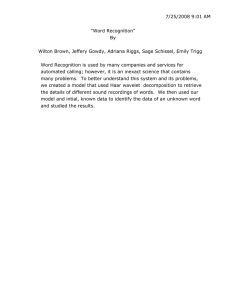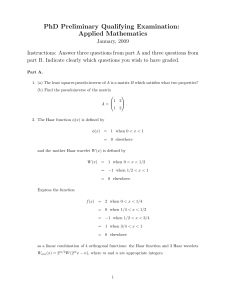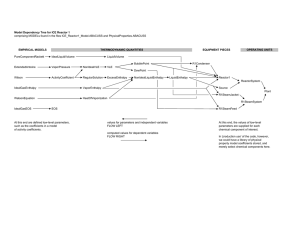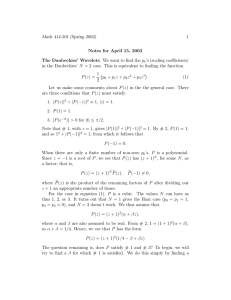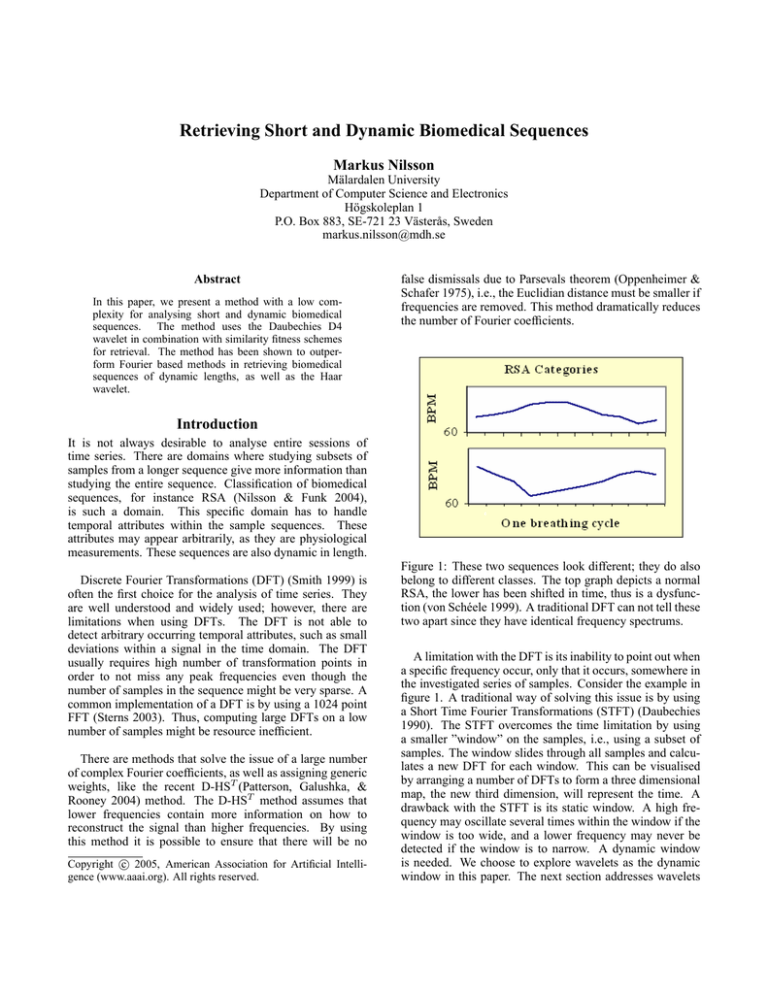
Retrieving Short and Dynamic Biomedical Sequences
Markus Nilsson
Mälardalen University
Department of Computer Science and Electronics
Högskoleplan 1
P.O. Box 883, SE-721 23 Västerås, Sweden
markus.nilsson@mdh.se
Abstract
In this paper, we present a method with a low complexity for analysing short and dynamic biomedical
sequences. The method uses the Daubechies D4
wavelet in combination with similarity fitness schemes
for retrieval. The method has been shown to outperform Fourier based methods in retrieving biomedical
sequences of dynamic lengths, as well as the Haar
wavelet.
false dismissals due to Parsevals theorem (Oppenheimer &
Schafer 1975), i.e., the Euclidian distance must be smaller if
frequencies are removed. This method dramatically reduces
the number of Fourier coefficients.
Introduction
It is not always desirable to analyse entire sessions of
time series. There are domains where studying subsets of
samples from a longer sequence give more information than
studying the entire sequence. Classification of biomedical
sequences, for instance RSA (Nilsson & Funk 2004),
is such a domain. This specific domain has to handle
temporal attributes within the sample sequences. These
attributes may appear arbitrarily, as they are physiological
measurements. These sequences are also dynamic in length.
Discrete Fourier Transformations (DFT) (Smith 1999) is
often the first choice for the analysis of time series. They
are well understood and widely used; however, there are
limitations when using DFTs. The DFT is not able to
detect arbitrary occurring temporal attributes, such as small
deviations within a signal in the time domain. The DFT
usually requires high number of transformation points in
order to not miss any peak frequencies even though the
number of samples in the sequence might be very sparse. A
common implementation of a DFT is by using a 1024 point
FFT (Sterns 2003). Thus, computing large DFTs on a low
number of samples might be resource inefficient.
There are methods that solve the issue of a large number
of complex Fourier coefficients, as well as assigning generic
weights, like the recent D-HST (Patterson, Galushka, &
Rooney 2004) method. The D-HST method assumes that
lower frequencies contain more information on how to
reconstruct the signal than higher frequencies. By using
this method it is possible to ensure that there will be no
c 2005, American Association for Artificial IntelliCopyright gence (www.aaai.org). All rights reserved.
Figure 1: These two sequences look different; they do also
belong to different classes. The top graph depicts a normal
RSA, the lower has been shifted in time, thus is a dysfunction (von Schéele 1999). A traditional DFT can not tell these
two apart since they have identical frequency spectrums.
A limitation with the DFT is its inability to point out when
a specific frequency occur, only that it occurs, somewhere in
the investigated series of samples. Consider the example in
figure 1. A traditional way of solving this issue is by using
a Short Time Fourier Transformations (STFT) (Daubechies
1990). The STFT overcomes the time limitation by using
a smaller ”window” on the samples, i.e., using a subset of
samples. The window slides through all samples and calculates a new DFT for each window. This can be visualised
by arranging a number of DFTs to form a three dimensional
map, the new third dimension, will represent the time. A
drawback with the STFT is its static window. A high frequency may oscillate several times within the window if the
window is too wide, and a lower frequency may never be
detected if the window is to narrow. A dynamic window
is needed. We choose to explore wavelets as the dynamic
window in this paper. The next section addresses wavelets
together with a method for retrieval, followed by a section
of tests and results. The final section in the paper is the conclusions.
Using Wavelets for Retrieval
Discrete Wavelet Transformations (DWT) (Daubechies
1990; Hippenstiel 2002) breaks down discrete signals
(read set of samples) to their principal frequencies based
on a function. DWTs use a dynamic function (window)
when computing frequencies.
This function changes
shape depending on what frequencies are to be analysed.
A general concept with DWT functions is that they are
more accurate in time when analysing higher frequencies
and more accurate in frequency interval when analysing
lower frequencies. There is always a trade-off between
these two parameters. A DWT function returns frequency
intervals instead of specific frequencies. This is illustrated
in figure 2. The figure illustrates a general template for
DWTs. The function returns frequency coefficients in
a 2-dimensional scale- and time shift matrix, instead of
frequency coefficients like in DFTs. Scale is the frequency
band and time shift is when in time the frequencies occur
(Bentley & McDonnell 1994). As we can see, the lowest
window, i.e. C7 , analyses the entire length in time but only
1
4 of the frequency compared to C1 .
Thus, the iterations required are in the order of log2 (n).
As an example, consider 3 frequency bands in figure 2
that are constructed from a set of 8 samples. 4 coefficients
are created in the highest frequency band, 2 coefficients
in the mid-band and a single coefficient in the lowest
frequency band. A scale variable is always left out. This
variable is needed for a possible reconstruction of the signal.
This transformation could also be viewed as passing the
signal through a high pass and a low pass filter where
the high pass filter retains the coefficients and the output
from the low pass filter is further iterated. The frequency
bands are calculated by using Nyquist’s sampling theorem
(Nyquist 1928), later proven in (Shannon 1949). The highest frequency band will have the interval of f2s − f4s , where
fs is the sampling frequency. The upper bound is due to
Nyquist as seen in equation 1, and the lower bound due to
the high pass filter (only the upper half of the frequencies
can be detected). The range f4s − 0 are a part of the scale
variables that passed the low pass filter. These variables will
be the samples to the next iteration, where they will be divided into f4s − f8s for the high pass filter, and f8s − 0 for the
low pass filter. By using a sample frequency of 4 Hz as an
example in figure 2, the high frequency band interval would
be 1 − 2Hz, the mid 0.5 − 1Hz and the low 0 − 0.5Hz.
N yquist : fmax =
C1
C2
C3
C4
Scale
C5
C6
C7
Time
Figure 2: A DWT with 7 frequency coefficients, 4 in the
high-band (C1 -C4 ), C5 and C6 represents the mid-band, and
C7 is in the lowest frequency band.
In practical terms, a wavelet function does basically
mean average samples in an iterative loop. The DWT
function calculates two different variable types, namely
frequency coefficients and intermediate scale variables.
The scale variables contain smoothed values, based on
averages of nearby samples; and the frequency coefficients
are the changes in the averaged samples. The coefficients
calculated in the same iteration are part of the same
frequency band. For n samples, there are n2 frequency
coefficients and n2 scale variables. The scale variables act
as the input to the next iteration of the DWT function.
fs
2
(1)
Nyquist Sampling Theorem, where fs is the sampling
frequency and fmax is the maximum detectable frequency
within the signal.
The complexities of the investigated DWTs in this paper
are in the order of O(log2 (n)), hence within the boundaries
of O(n). Chan and Fu has already established this for the
Haar DWT in (Chan & Fu 1999), however it that also applies to the D4 since it has the same complexity, compared
to the O(n log n) complexity of the FFTs (Sterns 2003).
We investigate two DWT functions in this paper, the Haar
and the Daubechies D4. The Haar was chosen because it
has already been investigated in retrieval, and it is the simplest DWT. The D4 was chosen because it overcomes some
limitations of the Haar.
Haar
The Haar (Haar 1910) DWT is quite straight forward. It
computes on pairs of samples. The function uses a pair of
samples as the input and result in a scale variable and a coefficient. The scale is the averaged value of the two samples
used in the pair, given by
sample(2i) + sample(2i + 1)
(2)
2
and the coefficient is the average change between the two
samples given by
scale(i) =
coef (i) =
sample(2i) − sample(2i + 1)
2
(3)
This requires the Haar to have an input of only two samples. A matrix illustrating the Haar DWT is shown in equation 4.
s
0.5 0.5
s0
=
×
(4)
0.5 −0.5
s1
c
s0 and s1 are the input samples, or previously calculated
scale variables. s is the new scale variable calculated by
the DWT. c is the frequency coefficient, i.e., the difference
between the two input samples. The Haar DWT has, as
mentioned earlier, already been investigated in (Chan & Fu
1999). They argue that the Euclidian distance is not preserved unless the function is normalised by √12 instead of 12 .
A limitation with the Haar is that it mean-averages only two
samples. As an example, consider a signal with the following sample sequence (5,5,25,25,5,5,25,25), where samples
oscillate between two states which is not uncommon in biomedical non-stationary signals. The effect of a Haar DWT
would be to miss out on the high frequency oscillations. This
is illustrated in figure 3.
samples
D4
Haar
40
30
20
where
h0 =
h2 =
√
1+√ 3
4 √2
3−√ 3
4 2
;
h1 =
;
h3 =
and s0 − s3 are the input samples. s0 and s1 are the
new scales; and c0 together with c1 are the frequency
coefficients.
The D4 steps two samples per calculation in the sequence
of samples even though it uses four samples as an input. This
causes a small problem when there are only two samples left
in the sequence. This problem is often addressed by making
the sequence longer. This can be done either by making the
sequence cyclic (start over with the first two samples) or by
mirroring the sequence.
Overcome the n2 boundary
A drawback of DWTs is that they are only able to process
sequences with sample lengths of n2 . The solution is to pad,
i.e., add something to the sequence without altering the information the signal carries.
We solve this by mean value the signal, i.e., lower (or
raise) the signal to oscillate around zero, as seen in equation
6. Once the sequence is mean valued, the sequence may be
padded with zeroes up to the nearest n2 boundary, without
introducing any artifacts.
10
n
0
sample(i)ni=1
-10
-20
1
2
3
4
5
6
7
8
5
5
25
25
5
5
25
25
D4
30
30
-17,32
-17,32
7,07
-7,07
7,07
-7,07
Haar
15
0
-10
-10
0
0
0
0
samples
Figure 3: An example where Haar has problems in detecting
oscillations in a signal.
The Haar DWT has sometimes problems with detecting
changes in the input samples. As we can see, the Haar reports zero frequency changes in the entire high band (the
rightmost 4 samples). The D4 wavelet detects the changes
better than the Haar.
Daubechies
The D4 DWT (Daubechies 1990) was introduced by
Daubechies in the late 80’s. The D4 overcomes the Haar’s
limitations by using 4 samples to calculate scales and coefficients. The D4 DWT matrix is
⎛
√
3+√ 3
4 √2
1−√ 3
4 2
⎞
s0
h0
⎜ c0 ⎟
=
⎝ s1 ⎠
h3
c1
⎛
⎞
s0
h1 h2 h3
⎜ s1 ⎟
×⎝
(5)
−h2 h1 −h0
s2 ⎠
s3
= sample(i) −
j=1
sample(j)
n
(6)
Weights
We adopted, and adapted, the weighting scheme from the
D-HST for our method. The sequence is normalised in the
range of -1 to 1 by the same means as in equation 6. The
normalised frequency coefficients are placed in slots
Θ − 1 if f c = 1
slot(c) =
(7)
Θc if f c < 1
where Θ is the number of slots that the normalised interval
is supposed to be divided into, and slot is the specific slot a
frequency coefficient c is associated with.
Each frequency band is assigned a weight as described by
1.0 if f ϑ = 0
weight(ϑ) =
(8)
1
if f ϑ > 0
2ϑ
ϑ is the sub band, i.e., frequency band, and weight(ϑ) is
the weight for the coefficients in the sub band. Thus, the
highest frequency band, as in the example in figure 2, has
the weight 1.0, the mid-band has weight 0.5 and the third
and lowest band has 0.25 as its weight.
Retrieval
We apply the weights to the entire set of coefficients in the
sequence. We use two different similarity methods depending on whether the sequences have the same length or not.
If two sequences has the same length they can be compared
with a straight forward method of comparing coefficients.
If two coefficients are in the same slot, they are said to be
similar, as seen in equation 9 and 10. Similarity for two coefficients is calculated by
match(a, b) =
weight if f
0
if f
slot(a) = slot(b)
slot(a) = slot(b)
to have a less or equal distance between the sequences. The
other two, worst and averaged fit is the ”what if” approaches,
where we under fit the similarities and see what happens.
Best fit The best fit uses the best match between coefficients representing the same sub band and relative time
span. Figure 5 illustrates the comparison. Here C0 has to
be matched against both C0 and C1 as they cover the same
area of scale and relative time. The best fit returns a match
if either C0 or C1 are in the same slot as C0 . There is an
over fit if only one of C0 or C1 are in the same slot as C0 .
The weight is returned as a measurement of similarity, in
this case 1.0.
(9)
The function match(a, b) returns the weight if sample a
and b are similar. weight is the local weight of the sub
band. slot() is given by equation 7. Similarity for the entire
sequence is calculated by
n
S=
(10)
i=1 eq(Ca (i), Cb (i))
where S is the total similarity, i.e., similarity for all coefficients in the sequence. Ca (i) is coefficient i in sequence
a. Cb is sequence b, and eq() is equation 9. An example
is illustrated in figure 4. Here are two sequences, each
carrying 7 coefficients. We can see that C0 and C0 matches
the same area in both time and frequency band. If the
coefficients C0 and C0 are in the same slot (equation 7),
they are deemed equal, and the weight (in this case 1.0) is
added to the similarity.
C'0 C'1 C'2 C'3
C''0 C''1 C''2 C''3
(1.0) (1.0) (1.0) (1.0)
(1.0) (1.0) (1.0) (1.0)
C'4
C'5
C''4
C''5
(0.5)
(0.5)
(0.5)
(0.5)
C'6
(0.25)
C''6
(0.25)
Figure 4: Frequency coefficients on sequences with the same
length are matched.
There are three schemes of comparing sequences of different lengths. We call these schemes best fit, worst fit and
averaged fit. In the case of best fit, we over fit the sequences
Figure 5: The best fit scheme where sequences with dissimilar lengths are compared.
An additional issue is the handling of sub bands that span
different frequencies. In figure 5, C6 is actually spanning
the same frequency band as C12
and C14
combined. There
are several ways of dealing with this issue. The easiest is to
ignore everything below the red line in the figure, i.e., coeffi
cients C6 , C12
, C13
and C14
. The second one is to compare
C6 with C12
, C13
and ignore the fact that they do not belong
to the same sub band. The third and final is to add the coefficient in the lowest sub band to its upper neighbouring sub
band, i.e., we add the value of coefficient C14
to coefficient
C12
and C13
. C6 is now comparable with C12
and C13
as
they are all representing the same sub band. We opted for the
last solution as we wanted to compare all frequency bands.
Worst fit Worst fit matches coefficients in the same manner as the best fit. The difference is that the worst fit scheme
returns the worst result. If we use the example in figure 5,
the worst fit will only return a match if both C0 and C1 are
in the same slot as C0 . Otherwise it is considered a miss and
the similarity value 0 is returned.
Average fit The average fit calculates the average match
of all coefficients in the area. In the case of figure 5
average =
match(C0 , C0 ) + match(C0 , C1 )
2
(11)
where slot() is given by equation 7.
the wavelet section.
Test and Results
Haar vs. D4
Haar avg
Haar best
Haar worst
D4 avg
D4 best
D4 worst
160
140
classified cases
120
100
80
60
40
20
0
10%
20%
30%
40%
50%
60%
70%
80%
90%
cases used in the library
Figure 6: A comparison of Haar and D4 DWTs with different similarity schemes.
We tested the three similarity fitness schemes on both
the Haar and the D4 DWT. In figure 6 a comparison of
the retrieval performance between the Haar and the D4
DWT with different similarity schemes is shown. The
horizontal axis denotes how many percent of the total
amount of available cases that is used in the case library.
The remaining cases are used in the retrieval test. 10%
means that approximately 10% of the set of 642 cases is
used in the case library, and that the remaining 90% is used
in the retrieval test. Higher marks on the vertical axis equals
more cases retrieved. As we can see, the D4 outperformed
the Haar when compared with the same similarity schemes
and the best fit similarity performed the best on both Haar
and D4. The Haar loses against the D4 because its inability
to pick up rapid changes within the signal, as described in
Differential diagnosis
Haar avg
D4 avg
Haar best
D4 best
Haar worst
D4 worst
50% 60% 70%
80% 90%
300
250
classified cases
The test was conducted by using a set of cases. A case contains a class identifier and a set of heart rate (HR) samples.
The cases are classified as belonging to one of 11 classes,
the classes can be viewed in (von Schéele 1999). The time
series in the cases, the sequences of HR, are measurements
from clinical work, thus some are from normal healthy
patients, and some are from patients suffering from different
dysfunctions. These HR time series vary in length because
they measure the heart activity during a breath, and a breath
is approximately 3 − 15 seconds. The sampling frequency
of the HR samples is 2 Hz, which leads us to expect sample
lengths up to 30 − 40 samples. The number of cases in the
test set is 642. Cases are divided in to two groups, cases
for the case library and cases used in retrieval test based on
the case library. Cases are semi-randomly fetched from the
set of cases to the two groups. The semi-random function
ensures that there is a good spread of cases from different
patients, sessions and classes.
200
150
100
50
0
10%
20% 30% 40%
cases used in the library
Figure 7: Differential diagnostics test where the first three
suggested classes in a match counts as beeing similar.
In the second test we tested differential diagnostics performance. Differential diagnostics is used to give clinicians
a broader range of support by suggesting more than one case
to compare to, as there might be a combination of factors in
a final diagnosis. In this case, suggesting several classes.
We suggest the 3 most similar classes in this test. If a case
is ranked within the top 3 of its actual class, it is considered
correctly classified. The results from the differential diagnostics test is shown in figure 7. The two DWTs with their
different similarity schemes are a lot closer in performance
in this test. The performance is basically the same for all,
accept that the D4 and the Haar with the best fit scheme is
just ahead of the other schemes above 50%. The distance is
closer because the probability of having a correct classification is increased by a factor of 3 for all DWT/scheme methods, which makes the weaker methods gain ground with several classification attempts as well as less cases to classify,
as we can see at the end of the graph.
As a comparison, we tested the D-HST and an ordinary
DFT with 128 complex frequency coefficients against the
DWTs with the best fit scheme. The DFT is implemented as
an FFT. The similarity measure for the DFT is the Euclidian
distance based on the energy of each frequency coefficient
given by
dist =
128
| xi | − | yi |
(12)
i=1
where dist is the Euclidian distance between the vectors, x
and y, who carries complex Fourier coefficients.
as a D4 has the complexity in the order of O(n) whereas
a FFT has O(n log n). The DWT is also preferable when
analysing temporal attributes in signals as the DWT is more
accurate in both time and frequency compared to DFT based
time-frequency methods.
DWT vs. DFT
D4 best
Haar best
D-HS´T
DFT128
180
160
classified cases
140
120
100
80
60
40
20
0
10%
20%
30%
40%
50%
60%
70%
80%
90%
These facts make DWTs candidates for retrieving relatively short biomedical time series. In tests, the DWT
outperformed the DFT. The best retrieval combination was
found to be the D4 with a best fit similarity scheme. The best
fit scheme over fits the similarity between two sequences in
the time-frequency domain. The D4 with the best fit clearly
outperformed other combinations accept in the differential
diagnostics test where there basically was a tie between all
retrieval methods.
cases used in the library
References
Figure 8: A comparison between time-frequency based
transformation methods (DWTs) and pure frequency based
methods (DFTs).
The D4 with the best fit scheme outperforms the DFTs,
as seen in figure 8. Here the D4 with the best fit scheme
shows improvement against the DFTs, but the Haar is
slightly behind the D-HST . However, the D-HST is at par,
or even outperforms our method in the beginning and in the
end of the graph. This is probably due to the asymmetric
distribution of cases in the test set. The cases are as
earlier mentioned collected from measurement sessions
from clinical every-day work. The more severe cases
containing dysfunctions are more infrequent than common
non-dysfunctional cases. The most common dysfunctions
are often classifiable by using only the frequency spectrum.
The equal performance between the DWTs and the DFTs
could be that the equation for determining the number of
cases from each class that is going to be in the case library
is a ceiling function. That is, if there are 3 cases of a specific
class in the set, and 70% of all cases are to be used in the
case library, the function 0.7 ∗ 3 returns 3. Hence, all 3
cases are used in the case library and no cases are left to be
matched against.
We also tried a non weighting scheme due to the fact
that small oscillations might be picked up by the higher frequency bands and thus would be impossible to tell which
frequency bands or parts of them that are more important
than others. This scheme of a static weight of 1 for all coefficients did perform poor in the tests. The D4 with the
best fit scheme is implemented in a decision support system, HR3Modul, for Respiratory Sinus Arrhythmia (Nilsson, Funk, & Xiong 2005); and it have proven to be successful. Furthermore, it would be quite interesting to see the
validity of this approach when applied to other domains and
their data sets.
Conclusions
The DWT has a couple of advantages compared to the DFT.
It is shown that a DWT is faster to compute than a DFT
Bentley, P. M., and McDonnell, J. T. E. 1994. Wavelet
transforms: an introduction. Electronics & communication
engineering journal 6(4):175–186.
Chan, K.-P., and Fu, A. W.-C. 1999. Efficient time series
matching by wavelets. In ICDE, 126–133.
Daubechies, I. 1990. The wavelet transform, timefrequency localization and signal analysis. IEEE transactions on information theory 36(5):961–1005.
Haar, A. 1910. Zur theorie der orthogonalen funktionensysteme. Mathematische Annalen 69:331–371.
Hippenstiel, R. D. 2002. Detection Theory. 2000 N.W.
Corporate Blvd., Boca Raton, Florida 33431: CRC Press.
Nilsson, M., and Funk, P. 2004. A case-based classification
of respiratory sinus arrhythmia. In Proceedings of the 7th
European Conference on Case-Based Reasoning, 673–685.
Nilsson, M.; Funk, P.; and Xiong, N. 2005. Clinical decision support by time series classification using wavelets.
In 7th International Conference on Enterprise Information
Systems. ICEIS’05.
Nyquist, H. 1928. Certain topics in telegraph transmission
theory. Transaction on AIEE 47:617–644.
Oppenheimer, A., and Schafer, R. 1975. Digital Signal
Processing. Englewood Cliffs, N.J.: Prentice-Hall.
Patterson, D.; Galushka, M.; and Rooney, N. 2004. An effective indexing and retrieval approach for temporal cases.
In Proceedings of the 17th International FLAIRS Conference, 190–195.
Shannon, C. E. 1949. Communication in the presence
of noise. Proceedings of Institute of Radio Engineers
37(1):10–21.
Smith, S. W. 1999. The Scientist and Engineer’s Guide to
Digital Signal Processing. San Diego, California: California Technical Publishing.
Sterns, S. A. 2003. Digital Signal Processing with Examples in Matlab. CRC Press.
von Schéele, B. 1999. Classification Systems for RSA,
ETCO2 and other physiological parameters. Heden 110,
821 31 Bollnäs, Sweden: PBM Stressmedicine.

